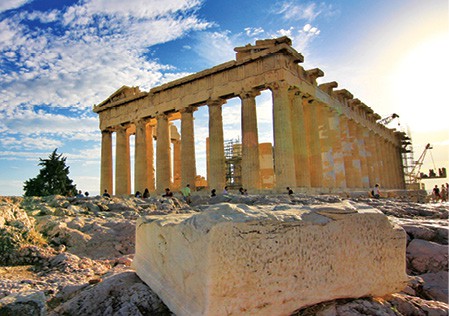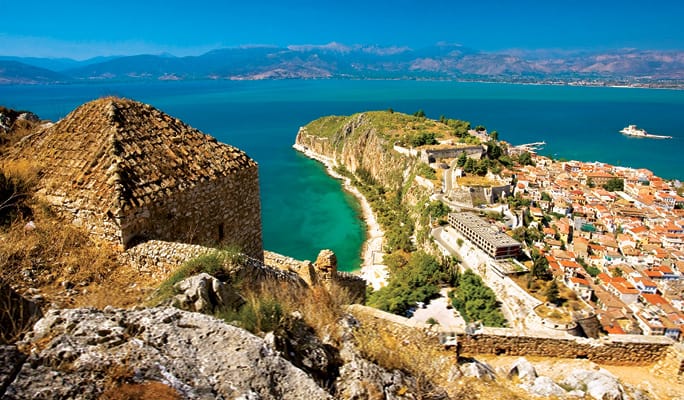[ad_1]
Few destinations offer as much ancient history and as many cultural landmarks as Greece. This Southern European hot spot boasts 18 UNESCO (United Nations Educational, Scientific and Cultural Organization) World Heritage Sites as well as a stunning mountainous landscape framed by the Aegean Sea. Though most of the Instagram glory focuses on the popular islands of Santorini, Mykonos and Crete, the country is actually composed of 6,000 islands—of which, 227 are inhabited. That leaves lots of room for under-the-radar options such as the magical Peloponnese region. As the largest peninsula in Greece, the Peloponnese is steeped in mythology and tradition. Here’s a five-day itinerary to catch the main sights:
Day 1: Archaeological
Wonders in Athens
Kick off your journey in iconic Athens, which is the historic capital of Europe, dating all the way back to the Neolithic Age. Head to Syntagma Square, where the neoclassical
Greek Parliament building looms. Surrounded by 40 acres of the lush National Garden, Syntagma Square also features the Monument of the Unknown Soldier, which is guarded by the Evzones, an elite infantry unit of the Greek Army. Every hour, crowds watch the striking “changing of the guards” ritual. Clothed in the traditional Greek uniform of foustanella, a pleated kiltlike skirt; red shoes topped with a pompom called tsarouchia; and a red hat called a phareon, the stoic guards slowly march into the square in pairs.
Walking through Athens’ cobblestone streets, lined with marble façades and ruins, is like meandering back through thousands of years. The historic center of the capital city houses must-see landmarks, including the Panathenaic Stadium, the Acropolis and the Acropolis Museum. Constructed in the 4th-century B.C., the Panathenaic Stadium hosted ancient Athenian celebrations and became the site of the modern Olympic Games in 1896. Stroll around the sprawling grounds and learn about its history during the 15-minute audio tour.
Nearby, the Acropolis stands as Greece’s most famous monument. The 500-foot archaeological wonder is so significant to Athens that buildings never top 12 floors, ensuring that views of the Acropolis are unobstructed. Perched on a jagged crag above the city, the Parthenon and other buildings of the Acropolis command attention. Built by Pericles in the 5th-century B.C., the Acropolis is a sacred site dedicated to the goddess Athena. As soon as you enter the landmark, you will sense its spiritual significance and the immense legacy of all the ancient people who once lived there. The climb to the site isn’t strenuous but the sun blazes down on the hill harshly, so early morning or late afternoon visits are best during the summer. Because crowds will surround most of the site, allow several hours to grab a close-up perspective, especially of the Parthenon, which displays no straight lines despite the illusion of straight columns at a distance. Don’t miss the Acropolis Museum, which supplies more artifacts and interesting insight into the construction and motivation for creating these monuments.
But Athens isn’t only about ancient history; check out the cafés, or tavernas, for heaping platters of Greek dishes such as choriatiki
salad and eggplant and beef moussaka. Visit the sprawling Monastiraki flea market, which consists of all kinds of shops and souvenir stores. Athens is a shopper’s dream in general, with distinctive clothes, jewelry and olive oil products, but every visitor should pick up a pair of handmade leather sandals. Not only is the quality, style and price unlike anything you’ll find in the U.S., but the well-crafted shoes are the perfect companion for taking on Greece’s uneven hills and cobblestone streets.
Days 2 and 3: Epidaurus, Nafplio and Mystras Castle
Dive into the attractions of the Peloponnese region with an exploration of the ancient theater of Epidaurus. Dedicated to Asclepius,
the god of medicine and built from 330-20 B.C., this classical Greek theater with perfect acoustics was actually part of a complex healing center. Hydrotherapy, music, massage, diet, exercise and theater all played a role in the holistic therapy, and you can check out the ruins for each area. The small Epidaurus museum displays some of the archaic (and scary) medical instruments as well as a statue of Asclepius with his familiar snake-wrapped staff, a symbol that still appears on some U.S. pharmacies and prescriptions.
Make your next stop the romantic town of Nafplio, where you will discover the essence of Peloponnese charm. This seaport is filled with fountains, medieval castles and olive tree-lined paths, and was the first capital of the newly formed Greek state from 1823–1834. Take a sunset stroll around the Arvanitia Promenade, and listen to live music, including opera, in the Old Town square. Next, traverse hills and old stone streets to the walled city of Mystras. The splendor of the town’s castles and grand churches captivates everyone who enters. Mystras rises above the emerald fields of the Eurotas valley with 12th-century arches, churches and the castle where the last emperor of Byzantium, Constantine XI, was crowned in 1448.
Days 4 and 5: Monemvasia, Diros Caves, Ancient
Messene and Kalamata
Located on a tiny island on the southeastern coast of the Peloponnese peninsula, Monemvasia supplies more fairy-tale allure than any children’s story. This hidden castle town dazzles with a natural fortress that skirts the Myrtoan Sea, winding cobblestone pathways, medieval mansions and a castle established in 582 A.D. Monemvasia is also where you’ll find Europe’s only medieval castle that has been continuously inhabited. Change course with an underground trip to the Diros Caves. This subterranean spectacle, one of the most important natural wonders of Greece, dates from 4000-3000 B.C. Floating through the caverns and viewing glistening
stalactites and stalagmites are a Peloponnese highlight.
Step into the world of Greek gods at the archaeological site of Ancient Messene. This well-perserved 2,000-year-old city boasts the Clepsydra spring where, according to myth, Zeus drank and showered, in addition to a Temple of Artemis, a stadium and a large shopping arena.
You can’t visit this nation without sampling its olives and wine, and there’s no place more essential for Greek flavors than Kalamata. Top off your travels by dropping into a seaside taverna. Stuff yourself with juicy purple Kalamata olives, tapenade with pita bread and fresh sea bream washed down with local wine as the breeze from the Aegean wafts over you.
Photo by puk Patrick/unsplash
Photos courtesy of GNTO/gfilippini; GNTO/E. Fili
- Nafplio
- Diros Cave
[ad_2]
Source link



